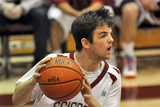What is Pierre Robin syndrome?
Pierre Robin syndrome is a congenital condition recently linked to genetic anomalies at chromosomes 2, 11 or 17. Often called Pierre Robin sequence, the disease is a chain of developmental malformations, each leading to the next. The condition is characterized by a smaller-than-normal lower jaw, a tongue that falls back in the throat and airway obstruction. In many cases, your child will also have cleft palate.
Watch this short video to learn more about Pierre Robin syndrome.
Causes
Pierre Robin syndrome can occur as an isolated anomaly or part of a syndrome. If the airway obstruction is not identified and managed, it may lead to hypoxia, right heart failure, failure to thrive, and feeding difficulties, in addition to cerebral impairment.
Testing and diagnosis
In all patients with suspected Pierre Robin syndrome, a complete airway assessment must be performed. If there is an associated laryngotracheal anomaly present, a tracheostomy may be required. Observation in a hospital and a sleep study (polysomnogram) are helpful in assessing the degree of airway obstruction.
Treatment
In more mild cases, management may consist of positioning your child in a side or face-down position to allow the tongue to fall forward and relieve the obstruction. Care may also include the addition of a nasopharyngeal airway until your child matures neurologically and has grown enough to bring the tongue into a more favorable position. In patients who are more severely affected or have abnormal sleep study results, surgical alternatives can be considered.
Surgical intervention includes tongue-lip adhesion, mandibular distraction or tracheostomy. Tongue-lip adhesion and mandibular distraction osteogenesis have both been performed with favorable outcomes.
In tongue-lip adhesion, the undersurface of the tip of the tongue is sutured to the inside of the lower lip to hold it in a more forward position. If successful, this is released in three to six months.
In distraction osteogenesis, an internal or external device is applied to the mandible and a cut is made posteriorly. By activating the device, the jaw is gradually brought forward carrying the tongue with it. This procedure improves the airway as new bone forms in the gap.
If neither of these procedures is successful or your child has disease below the base of the tongue, she may need a tracheostomy.
Long-term outlook
Babies with Pierre Robin syndrome are often treated in conjunction with the Neonatal Airway Program at CHOP. As your child grows, close monitoring of the airway, feeding, growth and development are important. Our Center for Pediatric Airway Disorders will play an integral role in your child’s care to monitor for any related airway issues that may develop. Some children may require a jaw lengthening procedure to address any ongoing issues.
Why choose us
Coordinated care is especially important for children with Pierre Robin syndrome because of the associated physical and developmental issues. At CHOP, children with Pierre Robin syndrome have access to the nation’s top pediatric specialists and coordinated care through our Craniofacial Program, one of the oldest, most experienced programs in the country dedicated to caring for children with craniofacial differences.
All clinicians work closely together to manage your child’s condition and connect her with any related services she may need, all within one institution. This includes psychosocial support services, the Neonatal Airway Program, the Center for Pediatric Airway Disorders and more.
Watch our educational video to hear more from clinicians and families about the coordinated care we provide to children with craniofacial conditions, including Pierre Robin syndrome.

Why Choose the Craniofacial Program
CHOP’s Craniofacial Program is one of the Nation’s leading treatment programs for children with both congenital and acquired anomalies of the face and skull.
Resources to help
Pierre Robin Syndrome Resources
Craniofacial Program Resources
We have gathered resources to give you information and help you find answers to your questions. We hope this makes your family's life a little easier.
Reviewed by Scott P. Bartlett, MD, Jesse A. Taylor, MD
